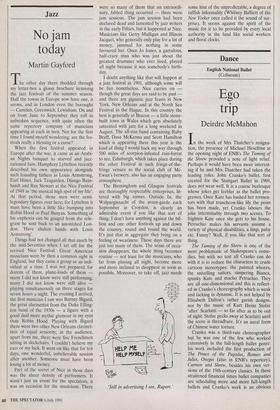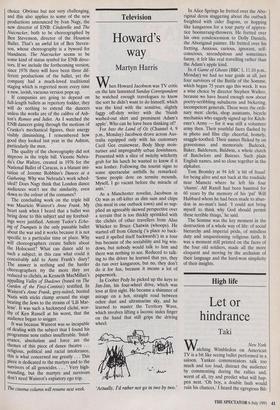Dance
Ego trip
Deirdre McMahon
In the week of Mrs Thatcher's resigna- tion, the presence of Michael Heseltine at the opening night of ENB's The Taming of the Shrew provided a note of light relief. Perhaps it would have been more interest- ing if he and Mrs Thatcher had taken the leading roles. John Cranko's ballet, first created for the Stuttgart Ballet in 1969, does not wear well. It is a coarse burlesque whose jokes get feebler as the ballet pro- gresses. Once Kate has bashed her tormen- tors with that truncheon-like lily the point has been made, yet Cranko labours the joke interminably through two scenes. To frighten Kate once she gets to his house, Petruchio makes his servants assume a variety of physical disabilities, a limp, palsy etc. Funny? Well, if you like that sort of thing.
The Taming of the Shrew is one of the most problematic of Shakespeare's come- dies, but with no text all Cranko can do with it is to reduce the characters to crude cartoon stereotypes: the painted whores, the snivelling suitors, simpering Bianca, spunky Kate and macho Petruchio. They are all one-dimensional and this is reflect- ed in Cranko's choreography which is weak and lacking in dynamic. It is not helped by Elisabeth Dalton's rather garish designs, nor by the music of Kurt Heinz Stolze `after' Scarlatti — so far after as to be out of sight. Stolze pecks away at Scarlatti until the score is threadbare. It's an aural form of Chinese water torture.
Cranko was a third-rate choreographer but he was one of the few who worked extensively in the full-length ballet genre: his work included the first production of The Prince of the Pagodas, Romeo and Juliet, Onegin (also in ENB's repertory), Carmen and Shrew, besides his own ver- sions of the 19th-century classics. In these straitened financial times ballet companies are scheduling more and more full-length ballets and Cranko's work is an obvious choice. Obvious but not very challenging, and this also applies to some of the new productions announced by Ivan Nagy, the new director of ENB: Cinderella and The Nutcracker, both to be choreographed by Ben Stevenson, director of the Houston Ballet. That's an awful lot of Ben Steven- son, whose choreography is a byword for blandness. The Nutcracker seems to be some kind of status symbol for ENB direc- tors. If we include the forthcoming version, since 1976 there will have been three dif- ferent productions of the ballet, yet the company had a much-loved traditional staging which is regretted more every time a new, lavish, vacuous version pops up.
If companies are going to depend on full-length ballets as repertory fodder, they will do nothing to extend the dancers unless the works are of the calibre of Ash- ton's Romeo and Juliet. As I watched the ENB dancers going through the motions of Cranko's mechanical figures, their energy visibly diminishing, I remembered how good they looked last year in the Ashton, particularly the men.
The quality of the choreography did not improve in the triple bill. Vicente Nebra- da's Our Waltzes, created in 1976 for the National Ballet of Caracas, is a blatant imi- tation of Jerome Robbins's Dances at a Gathering. Why was Nebrada's work sched- uled? Does Nagy think that London dance audiences won't see the similarity, even down to the colour of the costumes?
The concluding work on the triple bill was Mauricio Wainrot's Anne Frank. My heart sank when I heard that a ballet was being done to this subject and my forebod- ings were justified. Antony Tudor's Echo- ing of Trumpets is the only passable ballet about the war and it works because it is not specific to a particular time or place. Why will choreographers create ballets about the Holocaust? What can dance add to such a subject; in this case what could it conceivably add to Anne Frank's diary? The answer is nothing and the harder choreographers try the more they are reduced to clichés, as Kenneth MacMillan's appalling Valley of Shadows (based on The Garden of the Finzi-Continis) testified. In Wainrot's Anne Frank, grey-suited, booted Nazis with sticks clump around the stage beating the Jews to the strains of `Lili Mar- lene'. It was such a hackneyed cliché, wor- thy of Ken Russell at his worst, that the audience began to snigger.
It was because Wainrot was so incapable of dealing with the subject that I found his programme note rather insufferable. 'Intol- erance, absolutism and force are the themes of this piece of dance theatre . . . religious, political and racial intolerance, this is what concerned me greatly . . . This piece is dedicated to the martyrs and to the survivors of all genocides. . . . ' Very high- sounding, but the martyrs and survivors don't need Wainrot's expiatory ego trip.



















































 Previous page
Previous page